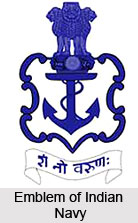 The history of the Indian Navy can be traced back to 1612 when Captain Best encountered and defeated the Portuguese. This encounter, caused by the pirates, forced the British East India Company to maintain a small fleet at Swally, near Surat (Gujarat). The First Squadron of fighting ships arrived on 5 September 1612, forming what was then called the Honorable East India Company`s Marine. It was responsible for the protection of the East India Company`s trade in the Gulf of Cambay and the river mouths of the Tapi and Narmada. The officers and the men of this force went on to play an important role in surveying the Arabian, Persian and Indian coastlines. The British had abducted Bombay in 1662; they physically took possession of the island to pass it on to the East India Company. As a consequence, the Honorable East India Company`s Marine also became responsible for the protection of trade off Bombay.
The history of the Indian Navy can be traced back to 1612 when Captain Best encountered and defeated the Portuguese. This encounter, caused by the pirates, forced the British East India Company to maintain a small fleet at Swally, near Surat (Gujarat). The First Squadron of fighting ships arrived on 5 September 1612, forming what was then called the Honorable East India Company`s Marine. It was responsible for the protection of the East India Company`s trade in the Gulf of Cambay and the river mouths of the Tapi and Narmada. The officers and the men of this force went on to play an important role in surveying the Arabian, Persian and Indian coastlines. The British had abducted Bombay in 1662; they physically took possession of the island to pass it on to the East India Company. As a consequence, the Honorable East India Company`s Marine also became responsible for the protection of trade off Bombay.
By 1686, with British commerce having shifted mainly to Bombay, the name of this force was changed to Bombay Marine. This force rendered unique service, fighting the Portuguese, Dutch and French, but also intruders and pirates of various nationalities. The Bombay Marine was involved in battle against the Marathas and the Sidis and participated in the Burma War in 1824. In 1830, the Bombay Marine was renamed `Her Majesty`s Indian Navy`. With the capture of Aden by the British and the institution of the Indus task force, the Navy`s commitments had grown diversely, and its employment in the China War in 1840 bears sufficient evidence to its ability.
At the same time as the Navy`s strength continued to grow, it underwent numerous changes of categorization over the next few decades. It was renamed the Bombay Marine from 1863 to 1877, after which it became `Her Majesty`s Indian Marine`. At this time, the Marine had two divisions, the Eastern Division based at Calcutta under the Superintendent, Bay of Bengal, and the Western Division at Bombay under the Superintendent, Arabian Sea. In acknowledgment of the services rendered during various campaigns, its title was changed to `Royal Indian Marine` in 1892, by which time it consisted of over 50 vessels. The Royal Indian Marine went into action with a fleet of minesweepers, tour vessels and troop carriers during the First World War when mines were detected off Bombay and Aden, and was utilized mainly for patrolling, ferrying troops and carrying war stores to Iraq, Egypt and East Africa.
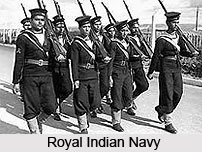
The first Indian to be granted a payment was subordinate Lieutenant D.N Mukherji who joined the Royal Indian Marine as an engineer officer in 1928. In 1934, the Royal Indian Marine was re-organized into the Royal Indian Navy, and was presented the King`s Color in 1935 in recognition of its services. At the outbreak of the Second World War, the Royal Indian Navy consisted of eight warships. By the end of the war, its strength had risen to 117 battle vessels and 30,000 workers who had seen action in various theatres of operations. On India attaining Independence, the Royal Indian Navy consisted of 32 aged vessels suitable only for coastal tour, along with 11,000 officers and men.
The senior officers were drawn from the Royal Navy, with R Adm ITS Hall, CIE, being the first Post-independence Commander-in-Chief. The prefix `Royal` was dropped on 26 January 1950 with India being constituted as a Republic. The first Commander-in-Chief of the Indian Navy was Admiral Sir Edward Parry, KCB, who handed over to Adm Sir Mark Pizey, KBE, CB, and DSO in 1951. Adm Pizey also became the first Chief of the Naval Staff in 1955, and was succeeded by V Adm SH Carlill, CB, and DSO. On 22 April 1958 V Adm RD Katari assumed office as the first Indian Chief of the Naval Staff.
Identity of the Indian Navy
Cadets: It is on board that life really begins for a naval officer in the Cadet Training Ship. Whether from the National Defence Academy or the Naval Academy, on joining the ship all become equal in their status as "the lowest form of marine life." Unlike the other Services, basic training brings naval cadets shoulder to shoulder with the men they will eventually command, and they are actually counted against the ship`s corporation. At the end of a six-month training period, successful Cadets are promoted to Midshipman.
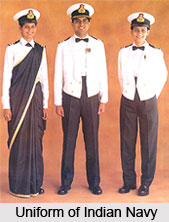 Officers: The word now encompasses all workers belonging to the officer cadre, a status, which entitles them to command men and singles them out as the most trusted representatives of the State. It is, however, traditional that only sea going officers from the Executive Branch are fortunate to command ships and head the Service. This tradition has since been codified in the Regulations for the Indian Navy.
Officers: The word now encompasses all workers belonging to the officer cadre, a status, which entitles them to command men and singles them out as the most trusted representatives of the State. It is, however, traditional that only sea going officers from the Executive Branch are fortunate to command ships and head the Service. This tradition has since been codified in the Regulations for the Indian Navy.
The different ranks of officer are as follows:
•Sub Lieutenants
•Lieutenant Commander
•Captains
•Admirals
•Lieutenants
•Commanders
•Commodores
Sailors: It has been fine said that in the Army, the men fight and the officers guide them. In the Air Force, the officers fight and the men support them; but in the Navy, both officers and men fight together, under equal and identical conditions fight together. Loyalty and group spirit are therefore an important part of the naval value system.
Salutes: It is generally agreed that the Hand salute is the first part of the movement of recognizing the head by removing head covering or throwing back the shade. The point to be noted is that it is not the individual who is being saluted, but it is the uniform and the rank of the superior, which is being given this consideration. On the upper decks of a ship, a junior salutes his superior officer on first meeting in the morning.
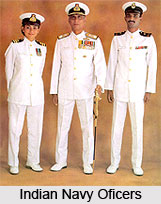 Burial at Sea: In the event of death on the ship, it is customary for the Medical Officer to report immediately to the Officer of the Watch, who then reports to the Captain. While the body is conserved and handed over to the relatives on shore. But in most cases, circumstances may rarely demand a burial at sea. In this event, all the staff not on vital duty attends the funeral, which is conducted by the Captain. The body appropriately sewn up in weighted shrouds is covered by the National Flag, which is removed just before the body is entrusted to the deep sea after the funeral service. There is a superstition that sea birds are spirits of dead sailors buried at sea, which is the reason why no sea bird will ever come to harm at the hands of a seaman.
Burial at Sea: In the event of death on the ship, it is customary for the Medical Officer to report immediately to the Officer of the Watch, who then reports to the Captain. While the body is conserved and handed over to the relatives on shore. But in most cases, circumstances may rarely demand a burial at sea. In this event, all the staff not on vital duty attends the funeral, which is conducted by the Captain. The body appropriately sewn up in weighted shrouds is covered by the National Flag, which is removed just before the body is entrusted to the deep sea after the funeral service. There is a superstition that sea birds are spirits of dead sailors buried at sea, which is the reason why no sea bird will ever come to harm at the hands of a seaman.
Flags, Crest & Motto: A warship`s suit of Colors comprises the National Flag and the Naval flag. These symbolize the State and the Navy respectively, and are held in high admiration by all ranks, indicating subordination to the Nation and the Service. The association of Colors with heroic deeds has caused them to be regarded with worship. In a sense, they symbolize the history of the Service. The Naval Crest consists of the Ashoka emblem, a soiled anchor and a shield, and its navy blue color. Below the crest is the motto of the Service `Shano Varuna` - meaning `May the Lord of the Oceans be Auspicious unto us`.
Uniform: The uniform of the Indian Navy has by and large been inherited from the Royal Navy. At the time of Independence, it was easy to identify the branch to which an officer belonged. While executive officers wore plain gold lace, other officers were notable by the colored piping between their stripes. Engineer officers had purple, electrical officers dark green, supply officers white, shipwright officers silver grey, education officers light blue, medical officers burgundy and dental officers orange. Today, however, only the burgundy color is used to identify medical and dental officers.
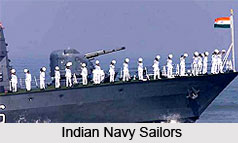
Beards & Moustaches: The degree of control exercised by customs and tradition on a naval officer or sailor can be seen from the fact that he is required to obtain his Commanding Officer`s utter permission in case he wishes to alter his facial appearance by growing a beard or a moustache, or by getting rid of one. Sailors have to make a formal request to discontinue shaving, and come up before the Executive Officer at `request men` for this purpose, while officers make a formal request to the Commanding Officer through their Head of Department. The custom of wearing a beard is odd to the Navy only. Army and Air Force employees are not extended this privilege other than those serving in commando units.
Indian Navy Operations
Various operations were carried out by the Indian Navy, against the country`s enemies, of which the important ones included are the Goa Operation - 1961, 1971 Operations, Operation Pawan 1987 and Operation Cactus 1988.
Honours of the Indian Navy
•Mahavir Chakra
•Vir Chakra
•Shaurya Chakra
•Kirti Chakra




















